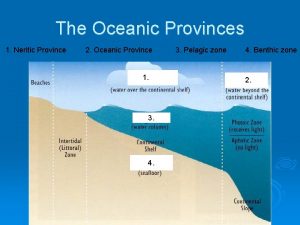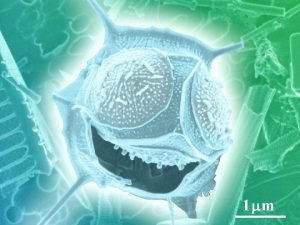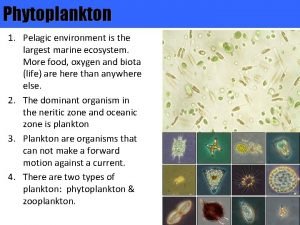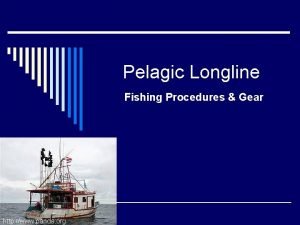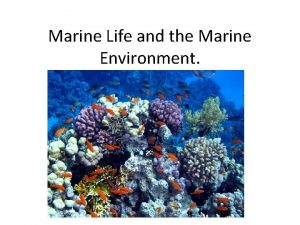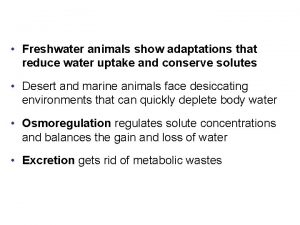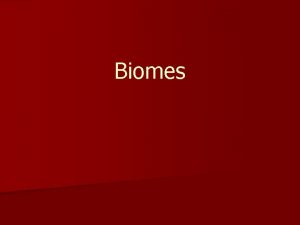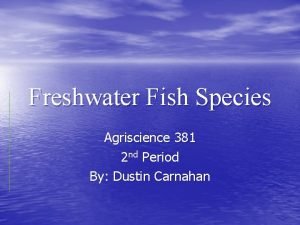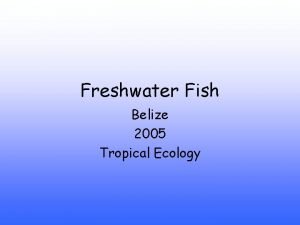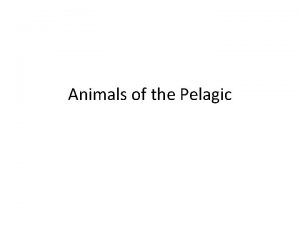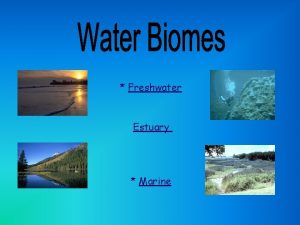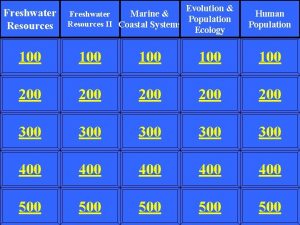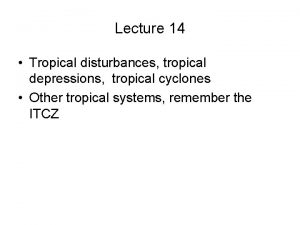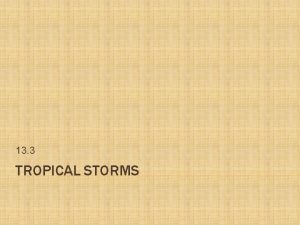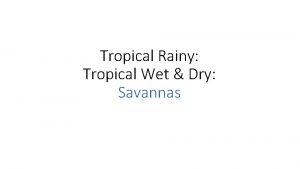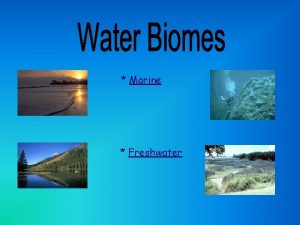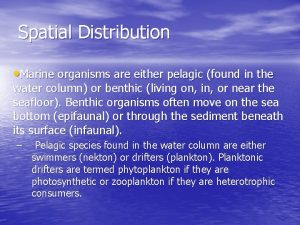World Families II Marine pelagic and tropical freshwater

























- Slides: 25

World Families II: Marine pelagic and tropical freshwater fishes November 27, 2012

Marine Pelagic Fishes • Of >25, 000 known fish species, ~15, 000 are marine • Majority are associated with seafloor, but a diverse community also occupies open water pelagic zone • More mobile and wide ranging than benthic fishes • Vary from small, schooling fish to large predators

Family List Engraulidae: anchovies Exocoetidae: flying fishes Megalopidae: tarpons Scombridae: tunas Sphyraenidae: barracudas Sphyrnidae: hammerhead sharks Istiophoridae: billfishes

Engraulidae: anchovies • Mouth inferior, very large, upper jaw produced • Gill rakers often numerous • Silver stripe down flanks • Abdominal scutes in OW species • Most species <15 cm

Exocoetidae: flying fishes • Name means “outside of home” • Unusually large pectoral fins, some species also with large pelvic fins (four-winged appearance) • Jaws relatively short • Caudal fin deeply forked, upper lobe shorter http: //www. youtube. com/watch? v=8 n. Ewte-x-iw

Megalopidae: tarpons • • • Large silvery fishes of tropical and subtropical waters Single dorsal fin without spines Fusiform, compressed body Lower jaw prominent Filamentous last dorsal ray

Scombridae: tunas • • • Body elongate and fusiform Snout pointed, premaxilla beaklike Mouth large with variable teeth Two dorsal fins, separate 5 -12 finlets behind 2 nd dorsal and anal Caudal deeply forked

Sphyraenidae: barracudas • Elongated body • Large-mouthed with lower jaw projecting forward bearing strong fanglike teeth • Upper jaw non-protractible (large prey) • Low pectoral fins, dorsal fins apart far

Sphyrnidae: hammerhead sharks • “sphyrna” = hammer • Head laterally expanded, with eyes and nasal openings wide-set (compared to other sharks) • Blades presumed to increase sensory capabilities • No spiracle • Viviparous

Istiophoridae: billfishes • Name means “sail carrier” • Premaxilla and nasal bones extremely elongated, forming spearlike bill or rostrum • Very narrow pelvic fins • Median keel on caudal peduncle

Tropical Freshwater Fishes

Tropical Freshwater Fishes • Tropical aquatic habitat includes some of the world’s largest rivers, e. g. , the Amazon, Madeira, Mekong, Orinoco, Negro, and Zaire • Tropical freshwater fishes threatened by rainforest destruction, damming of rivers, pollution, erosion, pet trade, introduction of exotics

Family List *Cichlidae: cichlids Gasteropelecidae: freshwater hatchetfishes Polypteridae: bichirs Potamotrygonidae: freshwater stingrays Toxotidae: archerfishes Channidae: snakeheads Loricariidae: sucker-mouthed armored catfishes Protopteridae: African lungfishes Ceratodontidae: Australian lungfishes *Osteoglossidae: arowanas Arapaimidae: arapaima and relatives *Lepisosteidae: gars *will not be tested

*Cichlidae: cichlids • Body shape variable, mostly moderately deep and compressed • Interrupted lateral line in most • Breeding activities highly organized • Mouthbrooders, substratebrooders • Highly speciose and widely distributed • Hippo cleaners *will not be tested

Gasteropelecidae: freshwater hatchetfishes • • • Enlarged, strongly convex muscular pectoral girdle Single dorsal fin, adipose fin present in larger species Jumping capabilities thanks to long pectorals Found in Central and South America Name means “stomach axe”

Polypteridae: bichirs • Name refers to series of finlets on dorsum • Body elongated or anguilliform with thick rhombic/ganoid scales • Symmetric caudal fin • Pectorals with lobed base • Some species without pelvics

Potamotrygonidae: freshwater stingrays • Name means “river, ” “three points” • Med to large batoids, with short stout tail • Dorsal surface usually covered with thorns or denticles • Most with spotted/colorful dorsum • Outline round

Toxotidae: archerfishes • • • Compressed, deep body Large eyes Mouth long with lower jaw longer Anal fin with three spines Spiny and soft dorsal continuous • archerfish on BBC

Channidae: snakeheads • • • 2 genera (1 Asian 1 African) Elongate body Lower jaw protruding Long dorsal and anal No spines in fins Introduced in CA, MD, and Southeast

Loricariidae: armored catfishes • Body covered with bony plates • Ventral sucker mouth, some with barbels • Adipose fin absent or, when present, with spine at front

Protopteridae: African lungfishes • Body moderately elongate • Threadlike pectorals and pelvics • Able to survive dry spells by aestivation (reduced metabolism, burrowed in mud and enveloped in mucus cocoon) • lungfish aestivation

Ceratodontidae: Australian lungfishes • Stout, elongate body with flattened head and small eyes • Large bony scales cover body • Fins flipper like • Caudal fin paddle shaped

Arapaimidae: bonytongues • • • 2 species: Arapaima and Heterotis Heterocercal tail Torpedo shaped body, large scales Long anal and dorsal set far back Pectorals low, pelvics set far back Air breathers

*Osteoglossidae: arowanas • Elongate, slender body with large scales • Barbels present at symphasis of lower jaw • Large mouth with markedly oblique gape • Name means “bony tongue” *will not be tested

*Lepisosteidae: Gars • Atractosteus tropicus – tropical gar • Distribution from Mexico to Costa Rica • Aquacultured as food fish; also overfished *will not be tested (on world families section
 Little families
Little families Hadopelagic
Hadopelagic Pelagic phytoplankton
Pelagic phytoplankton Pelagic phytoplankton
Pelagic phytoplankton Oscillating water column
Oscillating water column Benthic zone
Benthic zone Continental rise
Continental rise Plants in the abyssal zone
Plants in the abyssal zone Long line fishing kit
Long line fishing kit Pelagic zone
Pelagic zone Pelagic biome
Pelagic biome Benthos
Benthos Ocean food web
Ocean food web Old world language families
Old world language families Gersmehl diagram tropical rainforest
Gersmehl diagram tropical rainforest Freshwater animals adaptations
Freshwater animals adaptations Pie chart of freshwater and saltwater
Pie chart of freshwater and saltwater Climate latitude
Climate latitude Non living things in freshwater
Non living things in freshwater Wetlands biomes
Wetlands biomes Texas freshwater fish species
Texas freshwater fish species Freshwater fish of belize
Freshwater fish of belize River with tributaries
River with tributaries Biomes in water
Biomes in water 2 ducks
2 ducks Freshwater biomes facts
Freshwater biomes facts

